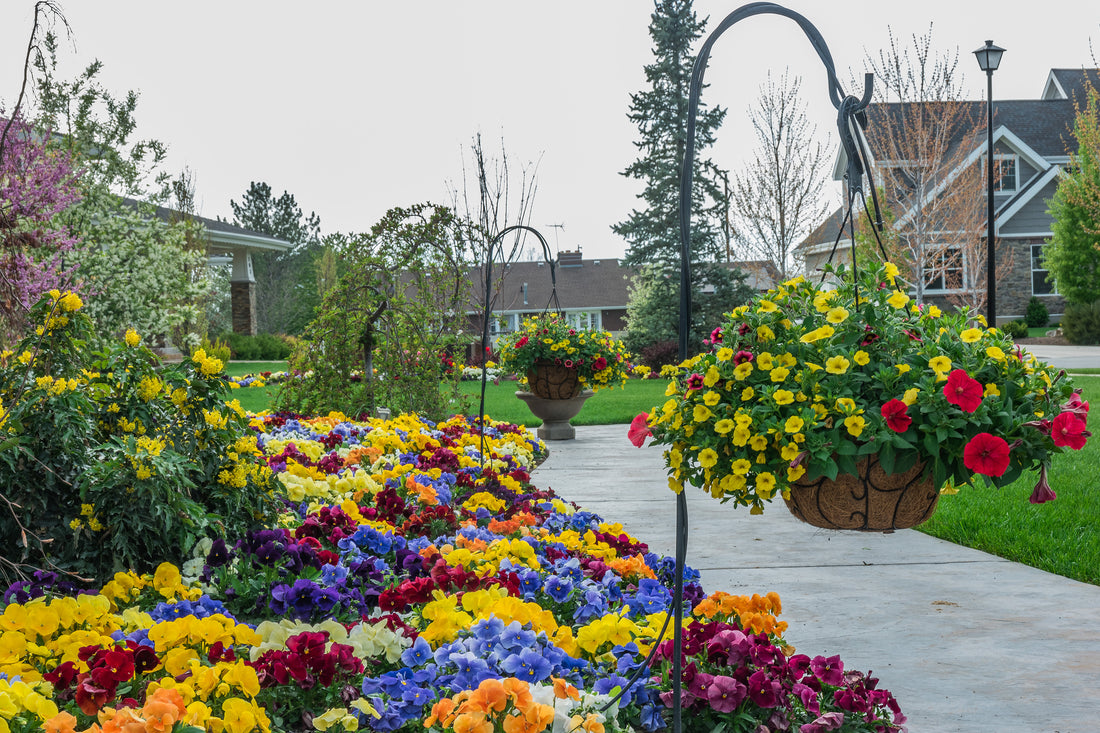Annual bedding plants are a popular choice for gardeners who want to add vibrant colors and textures to their outdoor spaces. These plants are called "annuals" because they complete their life cycle in one growing season and typically need to be replanted each year. In this blog, we'll cover everything you need to know about annual bedding plants, from fertilization and watering to plant needs and more.
What Are Annual Plants?
Annual flowers are plants that complete their life cycle in one growing season, typically from spring to fall. Unlike perennial plants, which come back year after year, annuals need to be replanted each year. However, annuals offer several advantages over perennials, including:
Faster growth and blooming: Annuals typically bloom within a few weeks of planting, while perennials may take several years to reach their full size and bloom.
Greater variety: Annuals come in a wide range of colors, sizes, and shapes, making them a versatile option for any garden.
Easy to grow: Many annuals are easy to grow and require minimal maintenance, making them a great choice for beginner gardeners.
Types of Annual Plants
There are many different types of annual bedding plants to choose from, each with its own unique characteristics. Some popular options include:
- Petunias: These colorful plants come in a wide range of shades and are known for their trumpet-shaped flowers.
- Calibrachoas: Also known as million bells, these flowers come in a variety of colors and patterns and bloom from Spring until frost.
- Snapdragons: Bright colors and fairly easy to grow. They are attracting pollinators and have a prolonged blooming period.
- Marigolds: Marigolds are easy to grow and come in a variety of sizes and colors, from bright yellow to deep orange.
- Pansies: A bright colorful cool-season annuals with a wide array of options. They add a loud pop to early spring and fall gardens.
- Impatiens: These shade-loving plants produce small, colorful flowers and are great for adding color to darker areas of your garden.
- Zinnias: Zinnias are known for their bright, bold colors and are a great choice for attracting pollinators like butterflies and bees.
Petunias
Petunias are amazing bloomers, found in nearly every color. With trumpet flowers and branching foliage that is hairy. With a wide range of petunia hybrids there is likely something for everyone. Whether is be single bloom, double bloom, striped, veined, solid, etc. Petunias are fast-growing flowers that reach full size as early as late spring.
When planting petunias, it is important to be aware of your zone and the last frost date. Petunias must not be exposed to frost. They will stay blooming all summer if they receive the sun, water, and fertilizer needed while deadheading and cutting old growth when needed.
Fertilization and Watering
Annual bedding plants require regular fertilization and watering to thrive. The best type of fertilizer for annuals is a balanced, water-soluble fertilizer that contains equal amounts of nitrogen, phosphorus, and potassium. This type of fertilizer will help promote healthy foliage, strong roots, and abundant blooms.
It's important to follow the instructions on the fertilizer package carefully, as over-fertilizing can damage the plants. Typically, annuals should be fertilized every two to three weeks during the growing season, starting about two weeks after planting.
Watering is another essential aspect of growing healthy annual bedding plants. Proper watering can help prevent wilting, promote strong root growth, and encourage abundant blooms. The best way to water annuals is to use drip irrigation or a soaker hose, which delivers water directly to the roots of the plants. This helps prevent water from evaporating too quickly and ensures that the plants receive the moisture they need. When it comes to watering, annual bedding plants typically need to be watered once or twice a week, depending on the weather conditions. Avoid watering in the middle of the day, when the sun is at its strongest, as this can cause the water to evaporate too quickly.
It's important to water deeply, so that the water reaches the roots of the plants. This typically means watering for about 30 minutes, two to three times per week, depending on the weather conditions. It's also important to avoid overhead watering, which can promote the growth of fungal diseases.
Specific Needs of Annual Bedding Plants
In addition to fertilization and watering, annual bedding plants have a few other needs that are important to keep in mind. For example, many annuals require full sun to thrive, so be sure to choose a spot in your garden that gets at least six hours of direct sunlight each day.
Different types of annuals have different needs when it comes to sun exposure, soil type, and other factors. For example, petunias and marigolds prefer full sun, while impatiens and begonias prefer partial shade. It's important to choose the right location for your plants based on their specific sun and shade requirements.
It's also important to choose the right soil for your plants. Annual bedding plants prefer well-draining soil that is rich in organic matter. If your soil is heavy or clay-like, consider adding compost or other organic matter to help improve drainage. It's also important to be aware of common pests and diseases that can affect annuals, such as aphids, spider mites, and powdery mildew.
Maintaining Healthy and Vibrant Annuals
To keep your annual bedding plants looking their best throughout the growing season, it's important to follow a few maintenance tips. Deadheading, or removing spent blooms, can help promote new growth and encourage the plants to continue blooming. Pruning can also help shape the plants and promote healthy growth.
Mulching is another important aspect of maintaining healthy annuals. A layer of mulch around the base of the plants can help retain moisture, suppress weeds, and regulate soil temperature. It's important to choose a high-quality mulch, such as shredded bark or compost, and apply it to a depth of about two inches.
Conclusion
Annual bedding plants are a great way to add color and texture to your garden and annuals offer a wide range of colors, sizes, and shapes, making them a versatile option for any garden. By following these tips for fertilization, watering, and plant needs, you can help ensure that your annuals thrive throughout the growing season. With a little bit of care and attention, your garden will be bursting with vibrant colors and beautiful blooms all summer long.

